什么是python的内置函数_什么是python内置函数

python的内置函数截止到python版本3.6.2,现在python一共为我们提供了68个内置函数。它们就是python提供给你直接可以拿来使用的所有函数。那今天我们就一起来认识一下python的内置函数。
为了方便记忆,已经有很多开发者将这些内置函数进行了如下分类:
·数学运算(7个)
·类型转换(24个)
·序列操作(8个)
·对象操作(7个)
·反射操作(8个)
·变量操作(2个)
·交互操作(2个)
·文件操作(1个)
·编译执行(4个)
·装饰器(3个)
接下来看看具体每个类别里包含了那些内置函数:






具体每个函数的解析如下:
数学运算
·abs:求数值的绝对值>>> abs(-2)
2
·divmod:返回两个数值的商和余数>>> divmod(5,2)
(2, 1)
>> divmod(5.5,2)
(2.0, 1.5)
·max:返回可迭代对象中的元素中的最大值或者所有参数的最大值>>> max(1,2,3) # 传入3个参数 取3个中较大者
3
>>> max('1234') # 传入1个可迭代对象,取其最大元素值
'4'
>>> max(-1,0) # 数值默认取数值较大者
0
>>> max(-1,0,key = abs) # 传入了求绝对值函数,则参数都会进行求绝对值后再取较大者
-1
·min:返回可迭代对象中的元素中的最小值或者所有参数的最小值>>> min(1,2,3) # 传入3个参数 取3个中较小者
1
>>> min('1234') # 传入1个可迭代对象,取其最小元素值
'1'
>>> min(-1,-2) # 数值默认去数值较小者
-2
>>> min(-1,-2,key = abs) # 传入了求绝对值函数,则参数都会进行求绝对值后再取较小者
-1
·pow:返回两个数值的幂运算值或其与指定整数的模值>>> pow(2,3)
>>> 2**3
>>> pow(2,3,5)
>>> pow(2,3)%5
·round:对浮点数进行四舍五入求值>>> round(1.1314926,1)
1.1
>>> round(1.1314926,5)
1.13149
·sum:对元素类型是数值的可迭代对象中的每个元素求和# 传入可迭代对象
>>> sum((1,2,3,4))
10
# 元素类型必须是数值型
>>> sum((1.5,2.5,3.5,4.5))
12.0
>>> sum((1,2,3,4),-10)
0
类型转换
·bool:根据传入的参数的逻辑值创建一个新的布尔值>>> bool() #未传入参数
False
>>> bool(0) #数值0、空序列等值为False
False
>>> bool(1)
True
·int:根据传入的参数创建一个新的整数>>> int() #不传入参数时,得到结果0。
0
>>> int(3)
3
>>> int(3.6)
3
·float:根据传入的参数创建一个新的浮点数>>> float() #不提供参数的时候,返回0.0
0.0
>>> float(3)
3.0
>>> float('3')
3.0
·complex:根据传入参数创建一个新的复数>>> complex() #当两个参数都不提供时,返回复数 0j。
0j
>>> complex('1+2j') #传入字符串创建复数
(1+2j)
>>> complex(1,2) #传入数值创建复数
(1+2j)
·str:返回一个对象的字符串表现形式(给用户)>>> str()
''
>>> str(None)
'None'
>>> str('abc')
'abc'
>>> str(123)
'123'
·bytearray:根据传入的参数创建一个新的字节数组>>> bytearray('中文','utf-8')
bytearray(b'\xe4\xb8\xad\xe6\x96\x87')
·bytes:根据传入的参数创建一个新的不可变字节数组>>> bytes('中文','utf-8')
b'\xe4\xb8\xad\xe6\x96\x87'
·memoryview:根据传入的参数创建一个新的内存查看对象>>> v = memoryview(b'abcefg')
>>> v[1]
98
>>> v[-1]
103
·ord:返回Unicode字符对应的整数>>> ord('a')
97
·chr:返回整数所对应的Unicode字符>>> chr(97) #参数类型为整数
'a'
·bin:将整数转换成2进制字符串>>> bin(3)
'0b11'
·oct:将整数转化成8进制数字符串>>> oct(10)
'0o12'
·hex:将整数转换成16进制字符串>>> hex(15)
'0xf'
·tuple:根据传入的参数创建一个新的元组>>> tuple() #不传入参数,创建空元组
()
>>> tuple('121') #传入可迭代对象。使用其元素创建新的元组
('1', '2', '1')
·list:根据传入的参数创建一个新的列表>>>list() # 不传入参数,创建空列表
[]
>>> list('abcd') # 传入可迭代对象,使用其元素创建新的列表
['a', 'b', 'c', 'd']
·dict:根据传入的参数创建一个新的字典>>> dict() # 不传入任何参数时,返回空字典。
{}
>>> dict(a = 1,b = 2) # 可以传入键值对创建字典。
{'b': 2, 'a': 1}
>>> dict(zip(['a','b'],[1,2])) # 可以传入映射函数创建字典。
{'b': 2, 'a': 1}
>>> dict((('a',1),('b',2))) # 可以传入可迭代对象创建字典。
{'b': 2, 'a': 1}
·set:根据传入的参数创建一个新的集合>>>set() # 不传入参数,创建空集合
set()
>>> a = set(range(10)) # 传入可迭代对象,创建集合
>>> a
{0, 1, 2, 3, 4, 5, 6, 7, 8, 9}
·frozenset:根据传入的参数创建一个新的不可变集合>>> a = frozenset(range(10))
>>> a
frozenset({0, 1, 2, 3, 4, 5, 6, 7, 8, 9})
·enumerate:根据可迭代对象创建枚举对象>>> seasons = ['Spring', 'Summer', 'Fall', 'Winter']
>>> list(enumerate(seasons))
[(0, 'Spring'), (1, 'Summer'), (2, 'Fall'), (3, 'Winter')]
>>> list(enumerate(seasons, start=1)) #指定起始值
[(1, 'Spring'), (2, 'Summer'), (3, 'Fall'), (4, 'Winter')]
·range:根据传入的参数创建一个新的range对象>>> a = range(10)
>>> b = range(1,10)
>>> c = range(1,10,3)
>>> a,b,c # 分别输出a,b,c
(range(0, 10), range(1, 10), range(1, 10, 3))
>>> list(a),list(b),list(c) # 分别输出a,b,c的元素
([0, 1, 2, 3, 4, 5, 6, 7, 8, 9], [1, 2, 3, 4, 5, 6, 7, 8, 9], [1, 4, 7])
>>>
·iter:根据传入的参数创建一个新的可迭代对象>>> a = iter('abcd') #字符串序列
>>> a
>>> next(a)
'a'
>>> next(a)
'b'
>>> next(a)
'c'
>>> next(a)
'd'
>>> next(a)
Traceback (most recent call last):
File "", line 1, in
next(a)
StopIteration
·slice:根据传入的参数创建一个新的切片对象>>> c1 = slice(5) # 定义c1
>>> c1
slice(None, 5, None)
>>> c2 = slice(2,5) # 定义c2
>>> c2
slice(2, 5, None)
>>> c3 = slice(1,10,3) # 定义c3
>>> c3
slice(1, 10, 3)
·super:根据传入的参数创建一个新的子类和父类关系的代理对象#定义父类A
>>> class A(object):
def __init__(self):
print('A.__init__')
#定义子类B,继承A
>>> class B(A):
def __init__(self):
print('B.__init__')
super().__init__()
#super调用父类方法
>>> b = B()
B.__init__
A.__init__
·object:创建一个新的object对象>>> a = object()
>>> a.name = 'kim' # 不能设置属性
Traceback (most recent call last):
File "", line 1, in
a.name = 'kim'
AttributeError: 'object' object has no attribute 'name'
序列操作
·all:判断可迭代对象的每个元素是否都为True值>>> all([1,2]) #列表中每个元素逻辑值均为True,返回True
True
>>> all([0,1,2]) #列表中0的逻辑值为False,返回False
False
>>> all(()) #空元组
True
>>> all({}) #空字典
True
·any:判断可迭代对象的元素是否有为True值的元素>>> any([0,1,2]) #列表元素有一个为True,则返回True
True
>>> any([0,0]) #列表元素全部为False,则返回False
False
>>> any([]) #空列表
False
>>> any({}) #空字典
False
·filter:使用指定方法过滤可迭代对象的元素>>> a = list(range(1,10)) #定义序列
>>> a
[1, 2, 3, 4, 5, 6, 7, 8, 9]
>>> def if_odd(x): #定义奇数判断函数
return x%2==1
>>> list(filter(if_odd,a)) #筛选序列中的奇数
[1, 3, 5, 7, 9]
·map:使用指定方法去作用传入的每个可迭代对象的元素,生成新的可迭代对象>>> a = map(ord,'abcd')
>>> a
>>> list(a)
[97, 98, 99, 100]
·next:返回可迭代对象中的下一个元素值>>> a = iter('abcd')
>>> next(a)
'a'
>>> next(a)
'b'
>>> next(a)
'c'
>>> next(a)
'd'
>>> next(a)
Traceback (most recent call last):
File "", line 1, in
next(a)
StopIteration
#传入default参数后,如果可迭代对象还有元素没有返回,则依次返回其元素值,如果所有元素已经返回,则返回default指定的
默认值而不抛出StopIteration 异常
>>> next(a,'e')
'e'
>>> next(a,'e')
'e'
·reversed:反转序列生成新的可迭代对象>>> a = reversed(range(10)) # 传入range对象
>>> a # 类型变成迭代器
>>> list(a)
[9, 8, 7, 6, 5, 4, 3, 2, 1, 0]
·sorted:对可迭代对象进行排序,返回一个新的列表>>> a = ['a','b','d','c','B','A']
>>> a
['a', 'b', 'd', 'c', 'B', 'A']
>>> sorted(a) # 默认按字符ascii码排序
['A', 'B', 'a', 'b', 'c', 'd']
>>> sorted(a,key = str.lower) # 转换成小写后再排序,'a'和'A'值一样,'b'和'B'值一样
['a', 'A', 'b', 'B', 'c', 'd']
·zip:聚合传入的每个迭代器中相同位置的元素,返回一个新的元组类型迭代器>>> x = [1,2,3] #长度3
>>> y = [4,5,6,7,8] #长度5
>>> list(zip(x,y)) # 取最小长度3
[(1, 4), (2, 5), (3, 6)]
对象操作
·help:返回对象的帮助信息>>> help(str)
Help on class str in module builtins:
class str(object)
| str(object='') -> str
| str(bytes_or_buffer[, encoding[, errors]]) -> str
|
| Create a new string object from the given object. If encoding or
| errors is specified, then the object must expose a data buffer
| that will be decoded using the given encoding and error handler.
| Otherwise, returns the result of object.__str__() (if defined)
| or repr(object).
| encoding defaults to sys.getdefaultencoding().
| errors defaults to 'strict'.
|
| Methods defined here:
|
| __add__(self, value, /)
| Return self+value.
|
***************************
·dir:返回对象或者当前作用域内的属性列表>>> import math
>>> math
>>> dir(math)
['__doc__', '__loader__', '__name__', '__package__', '__spec__', 'acos', 'acosh', 'asin', 'asinh', 'atan',
'atan2', 'atanh', 'ceil', 'copysign', 'cos', 'cosh', 'degrees', 'e', 'erf', 'erfc', 'exp', 'expm1',
'fabs', 'factorial', 'floor', 'fmod', 'frexp', 'fsum', 'gamma', 'gcd', 'hypot', 'inf', 'isclose',
'isfinite', 'isinf', 'isnan', 'ldexp', 'lgamma', 'log', 'log10', 'log1p', 'log2', 'modf', 'nan', 'pi',
'pow', 'radians', 'sin', 'sinh', 'sqrt', 'tan', 'tanh', 'trunc']
·id:返回对象的唯一标识符>>> a = 'some text'
>>> id(a)
69228568
hash:获取对象的哈希值
>>> hash('good good study')
1032709256
·type:返回对象的类型,或者根据传入的参数创建一个新的类型>>> type(1) # 返回对象的类型
#使用type函数创建类型D,含有属性InfoD
>>> D = type('D',(A,B),dict(InfoD='some thing defined in D'))
>>> d = D()
>>> d.InfoD
'some thing defined in D'
·len:返回对象的长度>>> len('abcd') # 字符串
>>> len(bytes('abcd','utf-8')) # 字节数组
>>> len((1,2,3,4)) # 元组
>>> len([1,2,3,4]) # 列表
>>> len(range(1,5)) # range对象
>>> len({'a':1,'b':2,'c':3,'d':4}) # 字典
>>> len({'a','b','c','d'}) # 集合
>>> len(frozenset('abcd')) #不可变集合
·ascii:返回对象的可打印表字符串表现方式>>> ascii(1)
'1'
>>> ascii('&')
"'&'"
>>> ascii(9000000)
'9000000'
>>> ascii('中文') #非ascii字符
"'\\u4e2d\\u6587'"
·format:格式化显示值#字符串可以提供的参数 's' None
>>> format('some string','s')
'some string'
>>> format('some string')
'some string'
#整形数值可以提供的参数有 'b' 'c' 'd' 'o' 'x' 'X' 'n' None
>>> format(3,'b') #转换成二进制
'11'
>>> format(97,'c') #转换unicode成字符
'a'
>>> format(11,'d') #转换成10进制
'11'
>>> format(11,'o') #转换成8进制
'13'
>>> format(11,'x') #转换成16进制 小写字母表示
'b'
>>> format(11,'X') #转换成16进制 大写字母表示
'B'
>>> format(11,'n') #和d一样
'11'
>>> format(11) #默认和d一样
'11'
#浮点数可以提供的参数有 'e' 'E' 'f' 'F' 'g' 'G' 'n' '%' None
>>> format(314159267,'e') #科学计数法,默认保留6位小数
'3.141593e+08'
>>> format(314159267,'0.2e') #科学计数法,指定保留2位小数
'3.14e+08'
>>> format(314159267,'0.2E') #科学计数法,指定保留2位小数,采用大写E表示
'3.14E+08'
>>> format(314159267,'f') #小数点计数法,默认保留6位小数
'314159267.000000'
>>> format(3.14159267000,'f') #小数点计数法,默认保留6位小数
'3.141593'
>>> format(3.14159267000,'0.8f') #小数点计数法,指定保留8位小数
'3.14159267'
>>> format(3.14159267000,'0.10f') #小数点计数法,指定保留10位小数
'3.1415926700'
>>> format(3.14e+1000000,'F') #小数点计数法,无穷大转换成大小字母
'INF'
#g的格式化比较特殊,假设p为格式中指定的保留小数位数,先尝试采用科学计数法格式化,得到幂指数exp,如果-4<=exp
则采用小数计数法,并保留p-1-exp位小数,否则按小数计数法计数,并按p-1保留小数位数
>>> format(0.00003141566,'.1g') #p=1,exp=-5 ==》 -4<=exp
'3e-05'
>>> format(0.00003141566,'.2g') #p=1,exp=-5 ==》 -4<=exp
'3.1e-05'
>>> format(0.00003141566,'.3g') #p=1,exp=-5 ==》 -4<=exp
'3.14e-05'
>>> format(0.00003141566,'.3G') #p=1,exp=-5 ==》 -4<=exp
'3.14E-05'
>>> format(3.1415926777,'.1g') #p=1,exp=0 ==》 -4<=exp
'3'
>>> format(3.1415926777,'.2g') #p=1,exp=0 ==》 -4<=exp
'3.1'
>>> format(3.1415926777,'.3g') #p=1,exp=0 ==》 -4<=exp
'3.14'
>>> format(0.00003141566,'.1n') #和g相同
'3e-05'
>>> format(0.00003141566,'.3n') #和g相同
'3.14e-05'
>>> format(0.00003141566) #和g相同
'3.141566e-05'
·vars:返回当前作用域内的局部变量和其值组成的字典,或者返回对象的属性列表#作用于类实例
>>> class A(object):
pass
>>> a.__dict__
{}
>>> vars(a)
{}
>>> a.name = 'Kim'
>>> a.__dict__
{'name': 'Kim'}
>>> vars(a)
{'name': 'Kim'}
反射操作
·__import__:动态导入模块index = __import__('index')
index.sayHello()
·isinstance:判断对象是否是类或者类型元组中任意类元素的实例>>> isinstance(1,int)
True
>>> isinstance(1,str)
False
>>> isinstance(1,(int,str))
True
·issubclass:判断类是否是另外一个类或者类型元组中任意类元素的子类>>> issubclass(bool,int)
True
>>> issubclass(bool,str)
False
>>> issubclass(bool,(str,int))
True
·hasattr:检查对象是否含有属性#定义类A
>>> class Student:
def __init__(self,name):
self.name = name
>>> s = Student('Aim')
>>> hasattr(s,'name') #a含有name属性
True
>>> hasattr(s,'age') #a不含有age属性
False
·getattr:获取对象的属性值#定义类Student
>>> class Student:
def __init__(self,name):
self.name = name
>>> getattr(s,'name') #存在属性name
'Aim'
>>> getattr(s,'age',6) #不存在属性age,但提供了默认值,返回默认值
>>> getattr(s,'age') #不存在属性age,未提供默认值,调用报错
Traceback (most recent call last):
File "", line 1, in
getattr(s,'age')
AttributeError: 'Stduent' object has no attribute 'age'
·setattr:设置对象的属性值>>> class Student:
def __init__(self,name):
self.name = name
>>> a = Student('Kim')
>>> a.name
'Kim'
>>> setattr(a,'name','Bob')
>>> a.name
'Bob'
·delattr:删除对象的属性#定义类A
>>> class A:
def __init__(self,name):
self.name = name
def sayHello(self):
print('hello',self.name)
#测试属性和方法
>>> a.name
'小麦'
>>> a.sayHello()
hello 小麦
#删除属性
>>> delattr(a,'name')
>>> a.name
Traceback (most recent call last):
File "", line 1, in
a.name
AttributeError: 'A' object has no attribute 'name'
·callable:检测对象是否可被调用>>> class B: #定义类B
def __call__(self):
print('instances are callable now.')
>>> callable(B) #类B是可调用对象
True
>>> b = B() #调用类B
>>> callable(b) #实例b是可调用对象
True
>>> b() #调用实例b成功
instances are callable now.
变量操作
·globals:返回当前作用域内的全局变量和其值组成的字典>>> globals()
{'__spec__': None, '__package__': None, '__builtins__': , '__name__':
'__main__', '__doc__': None, '__loader__': }
>>> a = 1
>>> globals() #多了一个a
{'__spec__': None, '__package__': None, '__builtins__': , 'a': 1, '__name__':
'__main__','__doc__': None, '__loader__': }
·locals:返回当前作用域内的局部变量和其值组成的字典>>> def f():
print('before define a ')
print(locals()) #作用域内无变量
a = 1
print('after define a')
print(locals()) #作用域内有一个a变量,值为1
>>> f
>>> f()
before define a
{}
after define a
{'a': 1}
交互操作
·print:向标准输出对象打印输出>>> print(1,2,3)
1 2 3
>>> print(1,2,3,sep = '+')
1+2+3
>>> print(1,2,3,sep = '+',end = '=?')
1+2+3=?
·input:读取用户输入值>>> s = input('please input your name:')
please input your name:Ain
>>> s
'Ain'
文件操作
·open:使用指定的模式和编码打开文件,返回文件读写对象# t为文本读写,b为二进制读写
>>> a = open('test.txt','rt')
>>> a.read()
'some text'
>>> a.close()
编译执行
·compile:将字符串编译为代码或者AST对象,使之能够通过exec语句来执行或者eval进行求值>>> #流程语句使用exec
>>> code1 = 'for i in range(0,10): print (i)'
>>> compile1 = compile(code1,'','exec')
>>> exec (compile1)
0
1
2
3
4
5
6
7
8
9
>>> #简单求值表达式用eval
>>> code2 = '1 + 2 + 3 + 4'
>>> compile2 = compile(code2,'','eval')
>>> eval(compile2)
10
·eval:执行动态表达式求值>>> eval('1+2+3+4')
10
·exec:执行动态语句块>>> exec('a=1+2') #执行语句
>>> a
3
·repr:返回一个对象的字符串表现形式(给解释器)>>> a = 'some text'
>>> str(a)
'some text'
>>> repr(a)
"'some text'"
装饰器
·property:标示属性的装饰器>>> class C:
def __init__(self):
self._name = ''
@property
def name(self):
"""i'm the 'name' property."""
return self._name
@name.setter
def name(self,value):
if value is None:
raise RuntimeError('name can not be None')
else:
self._name = value
>>> c = C()
>>> c.name # 访问属性
''
>>> c.name = None # 设置属性时进行验证
Traceback (most recent call last):
File "", line 1, in
c.name = None
File "", line 11, in name
raise RuntimeError('name can not be None')
RuntimeError: name can not be None
>>> c.name = 'Kim' # 设置属性
>>> c.name # 访问属性
'Kim'
>>> del c.name # 删除属性,不提供deleter则不能删除
Traceback (most recent call last):
File "", line 1, in
del c.name
AttributeError: can't delete attribute
>>> c.name
'Kim'
·classmethod:标示方法为类方法的装饰器>>> class C:
@classmethod
def f(cls,arg1):
print(cls)
print(arg1)
>>> C.f('类对象调用类方法')
类对象调用类方法
>>> c = C()
>>> c.f('类实例对象调用类方法')
类实例对象调用类方法
·staticmethod:标示方法为静态方法的装饰器# 使用装饰器定义静态方法
>>> class Student(object):
def __init__(self,name):
self.name = name
@staticmethod
def sayHello(lang):
print(lang)
if lang == 'en':
print('Welcome!')
else:
print('你好!')
>>> Student.sayHello('en') #类调用,'en'传给了lang参数
en
Welcome!
>>> b = Student('Kim')
>>> b.sayHello('zh') #类实例对象调用,'zh'传给了lang参数
zh
你好
什么是python的内置函数_什么是python内置函数相关推荐
- 数据库创建函数_达梦数据库创建UUID函数
数据库创建函数_达梦数据库创建UUID函数 接触达梦数据库有一段时间了,整理了一些资料,今天分享一下达梦数据UUID自定义函数 UUID函数定义 很多数据库都有提供UUID函数,可是接触达梦数据库后, ...
- python入门之函数调用内置函数_第九篇 python基础之函数,递归,内置函数
阅读目录 一 数学定义的函数与python中的函数 二 为何使用函数 背景提要 三 函数和过程 四 函数参数 五 局部变量和全局变量 六 前向引用之'函数即变量' 七 嵌套函数和作用域 八 递归调用 ...
- python中如何调用函数_如何调用python中的内置函数?(实例解析)
对于第一次接触到python这门编程语言的朋友来说,刚刚开始学习python编程的时候对于python函数调用这一方面的了解比较少,在这篇文章之中我们就来了解一下python怎么调用函数. Pytho ...
- 如何查看python有哪些内置函数_如何查看 Python 全部内置变量和内置函数?
查看python内置函数的方法:1.打开Python IDLE编辑器:2.输入" dir(__builtins__)"命令,按下回车键(Enter)得到Python全部内置变量和函 ...
- python vars name报错_简单瞅瞅Python vars()内置函数的实现
0.偶然间看到一个奇怪的现象 >>> x = 1 >>> a = var() >>> a['x'] 1 这是啥操作??用help(vars)之后, ...
- python字典内置方法_柳小白Python学习笔记 12 内置方法之字典方法
学习字典的时候只学习了最基本的字典定义和创建方式.今天再学习两种字典的创建方法及字典内置方法的使用. 现在春暖花开,所以我用花的元素创建了garden(花园)系列字典,字典的键是flowers(花名) ...
- python len函数_知识清单Python必备的69个函数,你掌握了吗?
本文纲要 Python 作为一门高级编程语言,为我们提供了许多方便易用的内置函数,节省了不少开发应用的时间.目前,Python 3.7 共有 69 个内置函数,一些是我们耳熟能详的函数,另一些却不是很 ...
- append函数_高质量python代码:考虑用生成器来改写直接返回列表的函数
写在前面:内容参照自<Effective Python>,其实你完全可以直接去看书,什么?你不想自己看书,那么你也可以关注我,我会不定期从书中挑出常用到的有效方法分享出来,这样你就可以一边 ...
- python中怎么调用函数_浅谈Python中函数的定义及其调用方法
一.函数的定义及其应用 所谓函数,就是把具有独立功能的代码块组织成为一个小模块,在需要的时候调用函数的使用包含两个步骤 1.定义函数–封装独立的功能 2.调用函数–享受封装的成果 函数的作用:在开发时 ...
最新文章
- Java程序员必看!java值类型和引用类型的区别
- 第7集 构造函数中抛出的异常
- Tomcat 怎么停止服务的?
- 在线画 有穷状态自动机 的软件_怎么画思维导图?不用下载软件,在线就能操作...
- 信息学奥赛一本通(1242:网线主管)
- Linux(五):Ubuntu 16.04 更改系统语言为简体中文(Chinese simplified)
- 【linux系统编程】基础开发工具:yum
- arm平台下的反汇编pdf_stm32逆向与安全科普,bin文件逆向反汇编
- POI导出Excel文件中文乱码
- shineblink 雨滴感应传感器
- 疑惑!AI中台到底为什么火了?道翰天琼认知智能机器人平台API接口为您揭秘。
- java 设置excel颜色_Java 为 Excel 中的行设置交替背景色
- 可路由计算引擎实现前置数据库
- 高飞助教介绍的他们所用无人机机架组成
- SCAU2021数据库综合性实验报告
- 微信小程序 基础语法
- 音乐播放器(附源码)
- java BeanUtils PropertyUtils
- D类音频放大器输出波形
- 职场--电挂支持之注意事项
